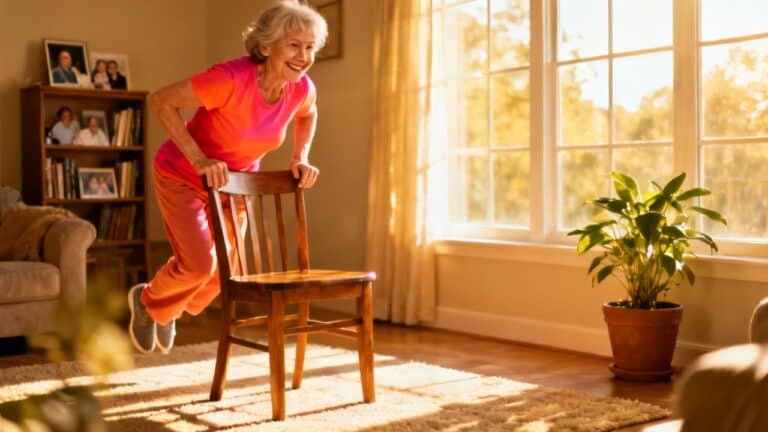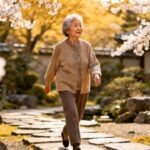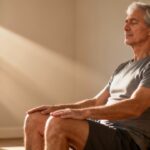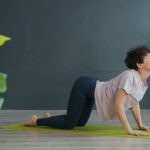What if the key to maintaining your independence and mobility as you age isn’t about complicated workouts or expensive equipment, but about unlocking the hidden power in everyday movements you’ve been doing your entire life?
Most fitness advice for seniors focuses on the basics—flexibility, balance, and muscle tone. But what if those simple movements like standing up from a chair or rising on your toes held neurological benefits that could transform how you walk, stand, and feel about your future?
Today, we’ll explore three powerful leg exercises specifically designed for seniors over 60 that go beyond physical strength to activate your brain, improve circulation, and rebuild confidence in your body’s capabilities.
Exercise 1: Chair Sit to Stand – The Brain’s Rehearsal for Independence
Most people think of sitting and standing as simple leg exercises, but this movement is actually one of the most powerful neurological rehearsals your body can perform. Every time you rise from a chair, you’re not just working your thighs—you’re training your brain to believe in your independence.
After age 60, one of the greatest threats to autonomy isn’t just weak muscles—it’s hesitation. The brain begins to second-guess: “Can I make it to the kitchen safely? Will I lose balance when I stand?” These doubts form neurological loops from years of reduced movement and subtle fear.
But the chair sit to stand movement is a powerful antidote. Each time you push up from a seated position with intention, you activate deep postural muscles, engage your core, strengthen glutes and quadriceps, and send a clear signal to your brain: “I am capable of rising. I am still in control.”
How to Perform Chair Sit to Stand Safely
- Choose a sturdy chair, ideally one without wheels
- Place it against a wall to prevent sliding
- Stand tall with feet shoulder-width apart, knees slightly bent
- Slowly lower into seated position, keeping chest lifted and back straight
- Pause briefly, then press through heels to rise using legs, not hands
- Breathe steadily—inhale as you lower, exhale as you rise
- Focus on slow, controlled repetitions rather than quantity
Exercise 2: Heel Raises – Rediscovering Your Hidden Sensors
Your ability to stay upright, walk with confidence, and react quickly to stumbles isn’t just about leg strength—it’s about your hidden sensors located in your ankles, feet, and calves. Heel raises are one of the simplest yet most powerful ways to wake them up.
These hidden sensors are part of your body’s proprioceptive system—the built-in GPS that tells your brain where you are in space. With age, these sensors can become less responsive if not regularly engaged, making falls more likely even on flat ground.
Heel raises are more than just a calf exercise—they’re a direct signal to your nervous system: “I’m still here. I’m still grounded. I know where I am.” Each time you rise up on your toes and lower with control, you activate the stabilizers that quietly keep you balanced every single day.
How to Perform Heel Raises with Intention
- Stand beside or behind a sturdy chair with hands resting lightly for balance
- Keep feet hip-width apart, grounded evenly
- Maintain tall spine, lifted chest, and relaxed shoulders
- Slowly lift both heels off the floor, rising onto toes
- Pause briefly at the top, feeling calves engage
- Lower heels back down slowly and mindfully
- Exhale as you rise, inhale as you lower
- Start with 10-12 repetitions, gradually increasing to 20-30
Exercise 3: Seated Leg Extensions – Building Circulation and Step Confidence
As we age, one of the lesser-known challenges is reduced blood flow and lymphatic movement in the legs. You might notice swelling in ankles, cold feet, or that heavy leg feeling after sitting too long. The seated leg extension is one of the gentlest, most effective ways to stimulate blood flow and nerve signaling through the lower limbs.
Each time you lift your leg, you activate your quadriceps—the large muscles at the front of your thigh that act like pumps, squeezing vessels and pushing blood back toward your heart. You’re also encouraging lymph fluid movement, which helps reduce swelling and supports your immune system.
But there’s a second layer to this exercise: step confidence. Many older adults begin to fear stairs, curbs, or uneven ground not because they’re weak, but because they’ve lost trust in how their legs respond. When you train your legs to extend with control, even seated, you rebuild neuromuscular trust.
How to Perform Seated Leg Extensions
- Sit tall in a sturdy chair with feet flat on floor
- Keep back straight and shoulders relaxed
- Slowly extend right leg forward, straightening knee until foot is off floor
- Hold for 1-2 seconds, feeling thigh engage
- Lower back down with control
- Switch to left leg and repeat
- Alternate between right and left legs
- Start with 10-15 reps per side, gradually increasing
Real-World Advice for Seniors
Movement isn’t about intensity—it’s about intention. You don’t need to sweat, strain, or do 50 perfect reps. What matters most is consistency, awareness, and connection.
Anchor these exercises to activities you already do:
- Do five chair stands every time you get up to make tea
- Sneak in heel raises while brushing your teeth
- Add 10 leg extensions before reading the morning paper
When fitness becomes part of your lifestyle rather than a separate event, it becomes effortless. That’s how you build strength without even thinking about it.
Most importantly, listen to your body, not your ego. Some days you may do more, some days less. Both are victories when you’re showing up with care and intention.
Who Should Avoid These Exercises?
If you’re recovering from recent surgery, have severe joint pain, dizziness, or uncontrolled blood pressure, please check with your doctor before starting any new exercise routine.
Conclusion: You’re Not Just Moving—You’re Rising
Today, you didn’t just lift your legs or arise from a chair. You activated the very systems that keep you independent, upright, and free. You sent signals to your muscles, brain, and balance center, reminding them you’re still in motion.
Too often older adults are told what they can’t do. But these three simple leg exercises prove otherwise. You’re not losing your edge—you’re sharpening it through intentional movements that many overlook, but your future self will thank you for.
Stay curious, stay consistent, and most of all, stay kind to your body. It’s listening, and it’s capable of more than you might imagine.








